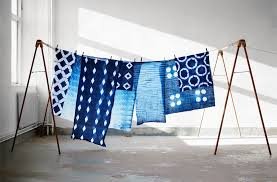The indigo color has long fascinated cultures across the globe, with its deep, rich hue evoking emotions that range from tranquility to introspection. This article explores the profound significance of the indigo color, tracing its historical roots, cultural implications, scientific properties, artistic applications, and its modern relevance in various fields, including fashion and interior design.
Table of Contents
The Historical Roots of Indigo Color
The indigo color has a history that dates back thousands of years, deeply entwined with various civilizations. The name “indigo” comes from the Latin word “indicum,” meaning “from India,” as the subcontinent was one of the first places to cultivate indigo for dyeing textiles. The process of extracting the dye from the leaves of the Indigofera plant involves fermentation, a method that has been used for centuries.
In ancient Egypt, indigo color was highly prized. It was used to dye garments worn by the elite and was even found in burial shrouds, emphasizing its importance in both life and death. Similarly, in ancient cultures of the Americas, such as the Mayans and Aztecs, indigo color was used in ceremonial garments, signifying fertility and power.
The demand for indigo color surged in the 17th century, particularly in Europe. The rise of the transatlantic slave trade led to the establishment of indigo plantations in the Americas, particularly in the southern United States and the Caribbean. This period marked both the height of indigo’s popularity and the darker aspects of its history, as its production was often linked to exploitation and colonization.
The Science of Indigo Color
From a scientific perspective, the indigo color is captivating. It is classified as a deep blue with a slight violet tint, situated between blue and violet in the visible spectrum. The wavelength of indigo color ranges from approximately 445 to 450 nanometers, giving it a unique character that is both soothing and stimulating.
Psychologically, the indigo color is associated with intuition, wisdom, and deep thought. It is believed to have calming effects, making it a popular choice in environments designed for meditation and relaxation. Many spiritual traditions associate indigo color with the third eye chakra, which symbolizes perception and enlightenment.
In color theory, the indigo color can be created by mixing blue with a small amount of red, resulting in a shade that can vary in depth and richness. Artists often use indigo color to create atmospheric effects, adding depth to their works and inviting contemplation.
Cultural Significance of Indigo Color

The indigo color holds unique meanings across different cultures. In India, it is not only a color but also a symbol of cultural heritage. Traditional indigo dyeing techniques, such as bandhani and block printing, have been passed down through generations. Indian artisans have perfected the art of dyeing, using natural methods to produce vibrant fabrics that reflect their heritage.
In Japan, the indigo color is celebrated through aizome, a dyeing technique that produces stunning fabrics with intricate patterns. The Japanese have a deep cultural connection to indigo color, using it in traditional clothing and home textiles. Aizome fabrics are not only beautiful but also carry historical significance, representing Japanese craftsmanship and aesthetics.
In Africa, indigo color is often used to create textiles that tell stories of community and identity. West African indigo cloth, adorned with intricate designs, symbolizes cultural pride and resilience. The indigo color is deeply embedded in African traditions, often used in ceremonies and celebrations.
The spiritual significance of indigo color is also noteworthy. It is seen as a color of protection and healing in various cultures, often associated with the night sky and the cosmos. This connection adds to the emotional and cultural richness of the indigo color.
Indigo Color in Art
Throughout history, the indigo color has been a favorite among artists. Its ability to convey depth and emotion has made it a prominent choice in various art movements. The Impressionists, for example, utilized indigo color to capture the effects of light and atmosphere in their landscapes. Artists like Claude Monet and Vincent van Gogh often incorporated indigo color into their works, creating stunning visual contrasts.
In contemporary art, the indigo color continues to inspire creativity. Many artists explore the cultural and historical significance of indigo color, using it as a medium for storytelling. The revival of traditional dyeing techniques has sparked renewed interest in indigo color, allowing artists to connect with their heritage while pushing the boundaries of modern art.
Additionally, indigo color is often used in textiles and crafts, further highlighting its artistic versatility. Quilters, weavers, and textile artists frequently incorporate indigo color into their works, celebrating its beauty and depth.
Indigo Color in Fashion
The impact of indigo color is particularly evident in the fashion industry. Indigo-dyed denim has become a staple in wardrobes around the world, symbolizing both style and durability. The rise of sustainable fashion has led to increased interest in natural indigo dyeing methods, prompting designers to explore eco-friendly options.
Fashion designers frequently incorporate indigo color into their collections, recognizing its versatility and timeless appeal. From casual wear to high-fashion pieces, the indigo color adds sophistication and depth to garments. Its ability to pair well with other colors makes it a favorite among designers seeking to create visually striking ensembles.
The resurgence of traditional indigo dyeing techniques has also contributed to the popularity of indigo color in fashion. Many contemporary brands are now embracing natural indigo, using it to create unique, environmentally friendly clothing options. This trend reflects a growing appreciation for craftsmanship and sustainable practices in the fashion industry.
Indigo Color in Interior Design
In the realm of interior design, the indigo color has gained popularity for its calming and sophisticated qualities. When applied to walls, textiles, or decor, indigo color can create a serene atmosphere, encouraging relaxation and tranquility. It is often used in spaces designed for meditation, wellness, and reflection.
Designers appreciate indigo color for its versatility, as it complements a variety of styles. Whether in a modern minimalist setting or a bohemian-inspired space, indigo color can serve as a focal point or a complementary hue. Its richness can transform a room, adding depth and dimension to the overall aesthetic.
The indigo color is also associated with grounding energy. It can create a sense of stability and comfort, making it an ideal choice for bedrooms and living spaces. Incorporating indigo color into interior design can enhance the emotional well-being of occupants, fostering a sense of peace and contentment.
The Environmental Impact of Indigo Dyeing

While the beauty of indigo color is widely celebrated, the methods of dyeing have historically raised environmental concerns. Traditional indigo dyeing processes often involved harmful chemicals that contributed to pollution and ecological damage. As awareness of these issues has grown, there has been a shift toward more sustainable practices.
The revival of natural indigo dyeing techniques is a promising development. Artisans and designers are increasingly prioritizing eco-friendly methods that minimize environmental impact. Natural indigo, sourced from plants, is gaining popularity as consumers seek sustainable and ethically produced textiles.
This movement toward sustainability not only preserves traditional crafts but also supports local communities. By choosing naturally dyed fabrics in indigo color, consumers can contribute to ethical practices that honor the environment and the artisans who create these beautiful products.
The Future of Indigo Color
Looking ahead, the indigo color will continue to evolve and inspire across various fields. The integration of technology in art and fashion provides new opportunities for exploring this rich hue. Digital tools enable artists and designers to experiment with indigo color in innovative ways, pushing the boundaries of traditional applications.
The ongoing emphasis on sustainability will shape the future of indigo color in fashion and design. As consumers demand more eco-friendly options, the popularity of natural indigo dyeing methods is likely to increase. This trend will not only preserve cultural heritage but also encourage new generations of artisans to embrace the beauty of indigo color.
In the wellness sector, the indigo color will continue to be embraced for its calming properties. Its association with meditation and mindfulness will keep it relevant in spaces designed for reflection and relaxation. As society navigates the complexities of modern life, the appeal of indigo color as a source of tranquility and introspection will endure.
Also read Vermin Supreme The Unconventional Political Icon
Conclusion
The indigo color is a rich and multifaceted hue that has left an indelible mark on human culture and creativity. From its historical roots in ancient dyeing practices to its modern applications in art, fashion, and design, the indigo color continues to inspire and captivate.
As we celebrate the depth and beauty of indigo color, we recognize its ability to connect us to our past, inspire creativity, and promote sustainability. Whether used in textiles, art, or design, the indigo color remains a powerful symbol of emotion and meaning.
In embracing the indigo color, we invite its essence into our lives—a color that symbolizes introspection, creativity, and cultural heritage. The journey of indigo color is far from over; it is an ever-evolving narrative that will continue to shape our perception of beauty and meaning for generations to come.


